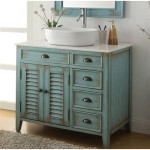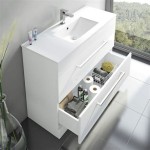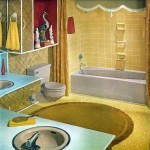Fiberglass Vintage Bathroom Sinks: A Comprehensive Overview
Vintage bathroom fixtures are experiencing a surge in popularity, driven by a desire for unique aesthetics and a connection to design eras of the past. Among these sought-after items are fiberglass vintage bathroom sinks. These sinks, prevalent from the mid-20th century through the late 1980s, offer a distinct alternative to modern materials like porcelain and ceramic. Understanding the properties, styles, and maintenance of fiberglass vintage bathroom sinks is crucial for homeowners and collectors interested in incorporating these pieces into their bathrooms.
Material Composition and Characteristics
Fiberglass is a composite material made by reinforcing a plastic matrix with glass fibers. In the context of bathroom sinks, this often involves a resin, such as polyester or epoxy, combined with woven or chopped strands of glass fibers. This combination results in a material that is relatively lightweight, strong, and moldable. The production process allows for a wide variety of shapes, colors, and integrated features, which contributed to its popularity during its peak production years. Unlike porcelain, fiberglass is less prone to chipping outright, though it can be scratched and stained.
The inherent properties of fiberglass offer several advantages for bathroom sink applications. Its lightweight nature simplifies installation, particularly in older homes where structural support might be a concern. The moldability of fiberglass makes it possible to produce sinks with integrated countertops, splash guards, and even soap dishes, streamlining the design and reducing the number of separate components needed. Furthermore, fiberglass can be pigmented during the manufacturing process, allowing for a range of vibrant and durable colors not easily achievable with other materials. The resilience of a fiberglass sink to temperature changes is noteworthy, as it doesn't expand and contract as dramatically as some other materials, reducing the risk of cracking due to thermal stress.
However, fiberglass is not without its drawbacks. It is more susceptible to scratching and staining than porcelain or ceramic. Prolonged exposure to harsh chemicals and abrasive cleaners can damage the surface, leading to discoloration and a dull appearance. Over time, the resin matrix can degrade, causing the fiberglass to become brittle and prone to cracking. Furthermore, older fiberglass sinks may yellow or fade due to exposure to UV light. The porous nature of fiberglass makes it more prone to absorbing odors and harboring bacteria if not properly maintained. Knowing these properties is important when considering a fiberglass sink for your bathroom.
Identifying Vintage Fiberglass Sink Styles
The mid-century modern and subsequent design movements heavily influenced the styles of fiberglass bathroom sinks. Common styles include wall-mounted sinks, pedestal sinks, and vanity top sinks. Wall-mounted sinks, often characterized by a minimalist design and clean lines, were popular for smaller bathrooms, maximizing floor space. Pedestal sinks provided a more substantial and elegant look, with a single support column concealing the plumbing. Vanity top sinks, integrated into a cabinet or countertop, offered storage space and a cohesive design aesthetic.
Color played a significant role in the aesthetics of vintage fiberglass sinks. Pastel shades, such as pink, blue, green, and yellow, were prevalent in the 1950s and 1960s, reflecting the optimistic and vibrant spirit of the era. Earth tones, such as avocado green, harvest gold, and brown, gained popularity in the 1970s, aligning with the natural and organic design trends of the time. White and off-white colors remained timeless choices, providing a neutral backdrop for various bathroom styles. The color choices for these sinks were not accidental; they were carefully considered to reflect the design trends in residential building during those eras.
Beyond color, specific design features distinguished different fiberglass sink styles. Some sinks featured rounded edges and smooth surfaces, while others incorporated sharper angles and geometric shapes. Integrated soap dishes, towel bars, and overflow drains were common features, adding functionality and convenience. Some sinks even featured molded-in decorative patterns or textures, enhancing their visual appeal. The integration of these elements contributed to the unique character and charm of vintage fiberglass sinks.
Identifying the manufacturer of a vintage fiberglass sink can also provide valuable information about its style and quality. Companies like American Standard, Kohler, and Crane produced a wide range of fiberglass sinks during their peak popularity. Identifying marks, usually stamped or molded onto the underside of the sink or the faucet deck, can help determine the manufacturer and date of production. Consulting online resources and antique guides can further assist in identifying specific models and styles.
Maintenance and Restoration of Fiberglass Sinks
Proper maintenance is essential for preserving the appearance and longevity of fiberglass bathroom sinks. Regular cleaning with mild soap and water is recommended to remove dirt, grime, and soap scum. Avoid using abrasive cleaners, scouring pads, or harsh chemicals, as these can scratch and dull the surface. For stubborn stains, a paste of baking soda and water can be applied gently and rinsed thoroughly. Regular waxing with a non-abrasive car wax can help protect the surface and maintain its shine.
Scratches and minor damage can often be repaired with readily available fiberglass repair kits. These kits typically include a resin filler, hardener, and color pigments to match the original sink color. The damaged area should be cleaned and sanded lightly before applying the resin mixture. After the resin has cured, it can be sanded smooth and polished to blend seamlessly with the surrounding surface. Professional refinishing services are also available for more extensive damage or discoloration.
Yellowing and fading can be addressed with specialized cleaning products designed for fiberglass. These products often contain mild bleaching agents that can help restore the original color. However, it is important to test these products in an inconspicuous area first to ensure they do not damage the surface. In some cases, painting the fiberglass sink with a specialized epoxy paint designed for bathroom fixtures may be the best option for restoring its appearance. Surface preparation is key to successful refinishing, requiring thorough cleaning, sanding, and priming before applying the paint. Multiple thin coats of paint are preferable to one thick coat, ensuring a smooth and durable finish.
Maintaining the plumbing associated with vintage fiberglass sinks is also crucial. Inspecting drain pipes and faucets regularly for leaks and corrosion can prevent water damage and ensure proper functionality. Replacing worn-out washers and O-rings can often resolve minor leaks. For more extensive plumbing issues, consulting a qualified plumber is recommended. Care should be taken when working with older plumbing fixtures, as they may be more fragile and prone to damage. When replacing or repairing plumbing components, ensure that the new parts are compatible with the vintage sink and meet current plumbing codes.
Restoring a vintage fiberglass sink to its original glory requires patience, skill, and the right tools and materials. However, the effort is often rewarded with a unique and characterful addition to the bathroom. By understanding the properties of fiberglass, identifying specific styles, and implementing proper maintenance and restoration techniques, homeowners and collectors can preserve these pieces of design history for years to come. The value of a vintage item often lies not just in its aesthetic appeal, but in the story it tells about a particular time and place. Therefore, understanding the historical context and manufacturing processes of vintage fiberglass sinks can enhance their appreciation and contribute to their preservation.

Paul Paints 3 Fiberglass Bathroom Sinks Diffe Colors At An Auto Retro Renovation

Paul Paints 3 Fiberglass Bathroom Sinks Diffe Colors At An Auto Retro Renovation

Wide Variety Of High Quality Bathroom Sinks Vintage Tub Bath

Paul Paints 3 Fiberglass Bathroom Sinks Diffe Colors At An Auto Retro Renovation

Whole Fiberglass Hand Wash Basin Bathroom Sink Crystal Glass China Made In Com

Lot 55 Of 246 Vintage Duratub Metal And Fiberglass Laundry Sink Wash Tub Tubs

Fiberglass Ceramic Or Porcelain Choosing Bathroom Fixtures Ace Plumbing Heating And Air Conditioning

Vintage Art Deco Royal Doulton Wall Hung Bathroom Sink Dragonquarry Antiques Restoration

Vintage Pedestal Sink Green Cast Iron Porcelain Bath Room

Paul Paints 3 Fiberglass Bathroom Sinks Diffe Colors At An Auto Retro Renovation
Related Posts







